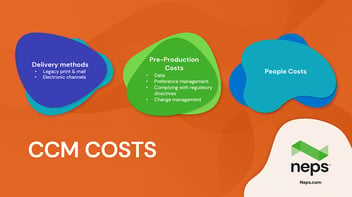Customer Communication Management (CCM) Technology
Notice :
Neps and Venture Solutions are now a singular CCM powerhouse.
© NEPS.com
It wasn’t long ago that invoices, statements, and letters were exclusively print based, using pre-printed custom base stock for static content and imprinting variable content in black. Over the past fifteen years, CCM production has undergone a dramatic digital transformation. Now, not only are email, SMS text, and online viewing gaining prominence, but the print and mail component has transitioned digitally as well.
Let’s overview the major technology groups within CCM production that make modern communications as efficient and reliable as we know them today.
Channel Delivery Technology
Technologies related to channel delivery, by nature, are the most prominent and recognizable of all CCM technologies for both workers and consumers.

Print & Mail: While the attention around digital transformation has revolved, rightfully so, around e-channels, there has also been dramatic change in print and mail technologies, both on the production floor and within the United States Postal Service.
- Top-tier CCM providers now handle their imaging using high-speed digital inkjet color printers, and static content is printed dynamically along with the variable content. In conjunction with printers, top-tier CCM providers now use fully digital inserters to create the letter package, allowing fully automated variable targeted inserting.
- While not quite to the level of lithographic printing, color rendering has greatly improved to the point where it satisfies nearly all branding standards. In fact, some direct marketing programs have now moved to inkjet printing to take advantage of its speed and cost.
- The frequent headlines about the operating deficit at the USPS have obscured its tremendous digital transformation, with particular headway occurring within the last fifteen years. The IMb—the Intelligent Mail Barcode—has allowed the USPS to track and report on mail at the piece level throughout the entire USPS distribution system, something unthinkable in the analog world. Additionally, the USPS has established an online reporting repository, as well as other supporting services like Secure Destruction and Informed Delivery.
e-Channels: The cost of postage, which continues to comprise about 70% of the overall expenses of print and mail communication, has been the primary motivation for CCM electronic delivery innovations over the past fifteen years. Postage can also be very unpredictable: some years may remain changed while other years have large rate spikes.
- Typically, email and SMS text channels do not deliver the communication content themselves but embed a link within an online application to where the consumer can view the content.
- Online viewing is used in conjunction with email and SMS text. However, it plays a much bigger role in customer communication, as it can also be used to access large archives of documents.
What’s often missed in this digitally-driven era is the opportunity to leverage all these channels as a single omnipresent channel; in fact, today’s channel delivery is often referred to as omni-channel—one all-encompassing channel. CCM behaves somewhat like direct marketing in this way, in that a strategic channel mix can bring relational and financial benefits.
Platform Technology
CCM production needs to process a wide variety of data input formats and compose pages in equally varied output formats, flawlessly, within a matter of seconds. The only way to achieve this high level of performance is to consolidate and automate these input and output functions within a common platform.
A platform capable of ensuring tasks are perfectly aligned, timed, integrated, and managed from a single source could arguably be the most critical piece of modern CCM technology.
The very best CCM platforms should excel in a few key functional areas:
- Processing data input from one or more internal information systems and standardizing it for personalized communication
- Preparing data to meet the requirements of each delivery channel, such as the USPS for mail and ISPs for email
- Composing static and variable content into pages and providing document files for production by each of the individual channels
For a deeper dive, we recommend checking out our article on CCM Platform. It provides more information about the challenges CCM managers face as they process data from their internal information systems, as well as managing the output preferences of their customer.
Over the past fifteen years, one of the biggest challenges in CCM communication has been the rise of government regulation, sparked by the housing and financial crisis of 2008. This period gave rise to the Federal Government’s Consumer Financial Protection Bureau (CFPB), as well as increased scrutiny within other industries such as healthcare.
The increase in government oversight and regulation has led to an equal demand for compliance, accountability, and verification. CCM programs now need to provide verification for requests concerning content send to a consumer, when it was sent, and 100% order fulfillment.
To meet this demand, top-tier CCM providers have installed systems that track content and deadlines down to the mail piece level. This has involved placing digital cameras on production equipment, inserting 2D barcodes on mail pieces for the cameras to capture, and managing the reporting of this tracking information within a database. This does not only extend to physical mail pieces; similar tracking mechanisms have been put into place for e-channels as well.
Self-Service Technology
As people have incorporated the convenience and speed of digital technology into their everyday lives, they have come to expect the same from their CCM services. From those working within the CCM industry in call centers and daily operations to those wanting to review their monthly mortgage payments or benefits from their recent doctor visit, communication expectations have never been higher.
Rising to the occasion, top-tier CCM service providers have developed digital tools that deliver the speed of digital consumer technology within the convenience of a fully integrated platform. The platform tools include:
- Document archiving, search, and viewing: This technology stores document images in their original state and allows users to search for the document for later review and retrieval. Not only are users allowed to view the document but also print it or send it elsewhere via email.
- Proofing and record deletion: A company can proof documents and remove unwanted records moments prior to production without the assistance of an external partner.
- Payment processing integrated with an invoice posting: Using a configured EBPP system, a company can self-manage many payment tasks that previously would have been handled by an external partner.
- Content editing and change management: This service tool allows a company to manage document templates and content on their own time; no longer do they need to rely on third-party providers to manage these tasks for them. It provides a great deal of control and flexibility, as well as substantial operational efficiencies. Of all the newer self-service solutions, comprehensive content management is the most impressive and relevant to modern business needs.
Rapid changes in CCM technology have transformed the production workflow from top to bottom, from printers and the USPS to electronic channels and self-service products. The CCM output service provider marketplace has been shaken up by companies better willing and able to keep pace and thrive in this new digital environment; many companies with in-plant CCM production have moved to external providers who have developed these impressive new solutions and crafted their trade.
As a company thriving in this new digital environment, Neps remains dedicated to keeping the progress rolling. Please reach out to us for further information about the technologies discussed in the article.



